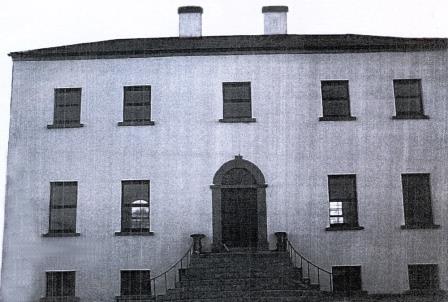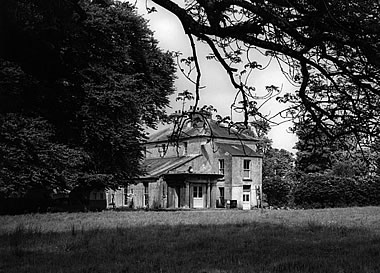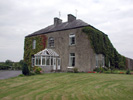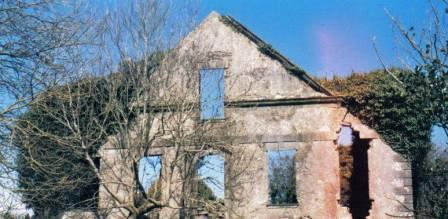Scor More
Houses within 10km of this house
Displaying 39 houses.
Houses within 10km of Scor More
Displaying 39 houses.
| House name | Description | |
|---|---|---|
| Estersnow Glebe | At the time of Griffith's Valuation the Ecclesiastical Commissioners were leasing a house at Cavetown valued at £10 to Rev. Frederick Hamilton. It is described as "a good glebe house, the residence of the incumbrant of Estersnow" at the time of the 1st Ordnance Survey. It is still extant and occupied. | |
| Ballymore | Alex Popham was leasing a house valued at £17 to Andrew Irwin at the time of Griffith's Valuation. Writing in 1786 Wilson refers to Ballymore as the seat of Pooley Shuldham, who may have been connected with the Longford family of that name. In 1814 Ballymore was the seat of Edward Elwood. In 1837 Lewis recorded it as the seat of Rev. J. Elwood. It is described as " a mansion in the possession of the late Rev. Elwood's family" at the time of the first Ordnance Survey. A house is still extant at Ballymore. |

|
| Camlin | The representatives of John Irwin, a minor, were leasing a house at Camlin, valued at £14, to James Badger, at the time of Griffith's Valuation. In 1837 Lewis also recorded Camlin as the seat of the Irwin family. At the time of the 1st Ordnance Survey, Camlin was being leased by John Irwin from the estate of Guy Lloyd and was described as "a good house of three stories". In 1814 it was the seat of John Irwin. At the time of the 1749 Census of Elphin a John Irwin lived at Camlin. |

|
| Moylurg House | In 1837 Lewis records Moylurg house as the seat of the Dick family. Rev. William Robertson was leasing a property valued at £25 to John Johnston, at Clogher, parish of Eastersnow, at the time of Griffith's Valuation. This appears to be Moylurg House which is still extant. Moylurg was the home of Major Henry Taaffe Ferrall in the 1870s. |

|
| Cavelawn | Guy Lloyd was leasing a house at Faus valued at £10 to James Acheson at the time of Griffith's Valuation. The house at this site is labelled Cavelawn on the 25-inch Ordnance Survey map of the 1890s. A house is still extant at the site. | |
| Havarine Cottage | Anna Maria Fry was leasing a house valued at £11 from Lord Lorton's estate at Tullyvohaun, barony of Boyle, at the time of Griffith's Valuation. At the time of the first Ordnance Survey Havarine Cottage, at Tullyvohaun, was described as a ''gentleman's seat', the residence of Mrs. Fry. | |
| Croghan | At the time of Griffith's Valuation, Guy Lloyd was the occupier of the house at Croghan, valued at £40. In 1749 the Census of Elphin shows that J. Lloyd, spinster, lived there. Wilson also notes it as a seat of the Lloyd family in 1786. Croghan House is no longer extant but an extensive range of outbuildings remains. |

|
| Cloverhill | At the time of Griffith's Valuation, Thomas Cox was leasing a house from the Lloyd estate at Bunreagh, barony of Boyle, valued at £10 . This property is labelled Cloverhill on the 25-inch map of the 1890s. A house and substantial farn are still extant at the site. | |
| Hermitage | Lewis records the Lloyd family occupying a second house called Hermitage also located in the townland of Croghan. Buildings still exist at the site. | |
| Carrowreagh | Richard O'Farrell Caddell was leasing a "herd's" house valued at £8, together with over 350 acres, at Carrowreagh, barony of Boyle, to Thomas Boylan, at the time of Griffith's Valuation. A house and farm are still extant at the site. Patrick Fox was leasing a mill property from the Caddell estate in the same townland. Some stone buildings remain at the site though the mill was described as "in ruins" on the 25-inch Ordnance Survey map of the 1890s. | |
| Finnor House | At the time of Griffith's Valuation, Richard O'Farrell Caddell was leasing a house valued at £8, at Finnor, barony of Boyle, to Michael Barrett. It s labelled "Finnor House" on the 25-inch Ordnance Survey map of the 1890s and a house still exists at the site. | |
| Bella | At the time of Griffith's Valuation Arthur O'Connor was the lessor of a caretaker's house, valued at £2 10s, as well as 136 acres. Lewis recorded Bella as the residence of E. French in 1837. A ruin is still extant at the site. An entrance gateway named Flynn's Cottage is visible here now! | |
| Dooneen | The representatives of Daniel Ferrall were leasing a property valued at £5 together with 200 acres to John Sharkey at the time of Griffith's Valuation. A farm is still extant at this location. | |
| Portobello | At the time of Griffith's Valuation, John Stafford was leasing a property at Portobello valued at £13 from Lord Lorton's estate. In 1814 it had been the residence of Thomas Stafford who Lewis also recorded as resident there in 1837. | |
| Ryefield | At the time of Griffith's Valuation Andrew Cummins was leasing a house at Ryefield valued at £17 to John Dowd. It was occupied by John Cummins, agent to Nicholas Cummins at the time of the first Ordnance Survey. | |
| Cloonshanville | William Davis was the occupier of a property valued at £8, together with over 120 acres at Leggatinty, barony of Frenchpark, at the time of Griffith's Valuation. In the same townland he was leasing a property, including a corn mill, valued at £18, to James McCann. In 1814 Paul Davis was resident at Clonchanville, Frenchpark and Lewis records this as the seat of J. Davis, in 1837. The 1749 Census of Elphin records W. Davis resident at Clegarna in the parish of Tibohine. Only some foundation stones of Cloonshanville Mill remain. There is a house, probably not original, on the site of Cloonshanville House. |

|
| Hermitage | Built by Charles O'Conor (1710-1790) the antiquarian and head of the family circa 1760. His great great grandson Charles O'Conor was leasing the property at Ballaghcullia, valued at £10, to Honoria O'Conor at the time of Griffith's Valuation. In 1749 the Census of Elphin records Denis O'Conor as being of "Ballinagar". The house at Hermitage is still extant though not occupied and a modern bungalow has been constructed in front of it. |

|
| Kilcorkey | Denis O'Conor held a property including a mill, valued at £10, at Kilcorkey, barony of Castlereagh, at the time of Griffith's Valuation. In 1749 the Census of Elphin recorded Richard Rutledge, gentleman, as the holder of a property in Kilcorkey. A house and extensive outbuildings still exist at the site but both have been modernised. The outbuildings have been coverted to living accommodation. An impressive standing stone is visible in the field close to the rear of the house. |

|
| Mount Druid | Denis O'Conor's house at Mount Druid, barony of Castlereagh, was valued at £35 at the time of Griffith's Valuation. In 1814 and 1837 the house was the seat of Matthew O'Conor. Slater refers to it as the seat of Charles M. O'Conor in 1894. A modest house survives at the site of Mount Druid but the stable yard remains are more elaborate. Fine trees still exist in the former demesne land. |

|
| Peak | Richard Irwin owned a herd's house and over 370 acres at Peak, barony of Castlereagh at the time of Griffith's Valuation. A modern house has been constructed at the site. | |
| Cloonyquin | Home of the French family, including the song writer Percy French, sold by the family in the 1950s. In 1786 Wilson refers to it as a seat of Arthur French in 1786. Valued at £24 in the mid 19th century. The house was demolished in the 1960s. See www.percyfrench.ie. |

|
| Smith Hill | Smithhill was in the demesne of The Palace at Elphin. It was the residence of the Reverend Oliver Jones, grandfather of Oliver Goldsmith, in the early 18th century. It was the home of Robert Jones Lloyd in the late 18th and early 19th century and of the Reverend John Lloyd in 1837. The house was unoccupied at the time of Griffith's Valuation when it was valued at £8 and held by Robert Lynch. The Ordnance Survey Field Name Books record that Goldsmith's father was born at Ardnagowna [or possibly Oliver himself, see http://en.wikipedia.org/wiki/Smith_Hill_(house)]. |

|
| Cavetown | In 1786 Wilson notes Cavetown as the seat of the Rev. Dean Mahon and the Reverend Arthur Mahon resided there in 1814. At the time of the first Ordnance Survey a ''gentleman's seat of two stories'' is noted in Cavetown. Guy Lloyd is recorded as the proprietor. This may be the property, valued at £5, leased from the Lloyd estate by Geo. Laird at the time of Griffith's Valuation. There are buildings still extant at this site. |

|
| Granny | At the time of the first Ordnance Survey Granny was described as ''a good farmhouse, the residence of the proprietor'' who was Thomas Irwin. Both Leet and Lewis record the Irwin family having a seat at Granny, near Boyle, in 1814 and 1837 respectively. A modern building is extant at the site now. | |
| Rushfield | At the time of the first Ordnance Survey Mr. A. Irwin is noted as the occupier of one of two ''gentlemen's seats' at Tullyvohaun, barony of Boyle. In 1814 it was the residence of John Irwin. This property was valued at £8 and was occupied by William Phibbs at the time of Griffith's Valuation. A substantial farm still exists at the site. | |
| Mantua | Built in the mid 18th century and owned by the Grace family in the 18th and 19th centuries. Occupied by R. Underwood in 1778. In 1786 Wilson notes that it was the seat of the late Richard Underwood and of Captain Grace. The 1st edition Ordnance Survey map indicates that it had elaborate gardens with a fishpond and terrace. It was owned by Edward F. Bowen in 1906. Mantua is now a ruin. | |
| Rush Hill | Home of the Devenish family in the 18th and 19th centuries, held from Sir Gilbert King. Funding received from the Heritage Council in 2005 for the restoration of this house. http://www.iol.ie/~oldbuilders/oldbuilders/rushhill/rushhill_01.htm. A detailed history and account of ongoing improvements to Rush Hill can be found at the blog www.irishaesthete.com tagged as Rush Hill. |

|
| Lissadorn | Lissadorn was a Crofton home from the mid 17th century. It became a Lloyd home in the 18th century following the marriage of Catherine Crofton and John Yeadon Lloyd in 1786. By 1814 Joseph Healy was living at Lisadurn. Burke's ''Landed Gentry of Ireland'' (1904) records the second son of Walter Balfe of Heathfield as John Balfe of Lissadorn. J. Balfe was residing at Lissadorn in 1837. At the time of Griffith's Valuation, Bernard Balfe held Lissadorn, valued at £20, from Viscount Lorton. It is no longer extant. On the first Ordnance Survey map (1838) the demesne included a smaller house named Ryefield. |

|
| Clogher Beg | Mary Gormley writes that this house was built by the Knoxes who acquired some of the Plunkett of Castle Plunkett estate. Occupied by Thomas Stafford at the time of Griffith's Valuation, held from James Murphy. | |
| Foxborough | In 1786 Wilson refers to Foxborough as the seat of Arthur French. Occupied by Patrick Taaffe at the time of Griffith's Valuation, who was leasing from Christopher French. The house was then valued at £20. It is now a ruin though the stable yard survives. | |
| Raheen | Occupied by Major Fawcett in 1837 and by John Irwin in the mid 1850s who held the property from Francis Murphy. In 1840 John Irwin had married Margaret Harken of Raheen House, Elphin. |

|
| Bettyfield | Recorded as the seat of Sir John Conroy or O'Mulconry in the Ordnance Survey Field Name Books. Arthur O'Connor was the main tenant in the townland of Shankill at the time of Griffith's Valuation. | |
| Cherryfield | Home of the Mills family in 1778. Noted by Wilson as "the fine seat of Oliver Mills" in 1786. Lewis refers to it as a seat of the same family in 1837. It was occupied by Michael Butler in the 1850s and held from John Carroll, valued at £10. It came into the ownership of the McGreavy family in the latter part of the nineteenth century and remained in their possession until the 1960s. It is now derelict. | |
| Beech Abbey | Originally a Begg residence, Beech Abbey in the mid 1850s was occupied by William Acheson, who was the main tenant of the Babington lands in the parish of Aughrim. The house was only valued at £2.10 shillings. It appears to have fallen into ruin by the 1890s. | |
| The Palace | Built as the residence of the Protestant Bishop of Elphin in 1685 from money bequeathed by Bishop Hudson. Altered in the mid 18th century and remained as the Bishop's residence until 1845. At the time of Griffith's Valuation the home of Arthur O'Conor, younger brother of Denis O'Conor of Mount Druid. Valued then at £55 and held from the Ecclesiastical Commissioners. Accidentally burnt in 1911, the main block is now demolished. | |
| Kinard | Possibly a Plunkett house at the end of the 18th century. At the time of Griffith's Valuation John Clarke occupied the house which he held from James Somerville, valued at £5. It is labelled Kinard House on both the 1st and 25-inch edition Ordnance Survey maps. A house is still extant at the site. | |
| Rossmore | Rossmore East was part of the estate of James Murphy at the time of Griffith's Valuation. The house was built circa 1860s (Buildings of Ireland). However the Ordnance Survey Field Name Books record a house and large gardens in the 1830s. |

|
| Bellanagare Castle | Bellanagare was the home of the O'Conor family including the well-known historian Charles O'Conor. It is noted by Wilson as his seat in 1786. He later built Hermitage House some distance away and Bellanagare Castle is now in ruins. |

|
| Ballyoughter | Occupied by John Goldsmith at the time of Griffith's Valuation. He held the house valued at £8 and 60 acres from Marcus McCausland. Another John Goldsmith was residing in Ballyoughter a hundred years earlier at the time of the Elphin Census. Wilson also refers to the house as the seat of Mr. Goldsmith in 1786. A later house, also named Ballyoughter House, is shown on the 25-inch Ordnance Survey map of the 1890s and there is still a house at this site, |

